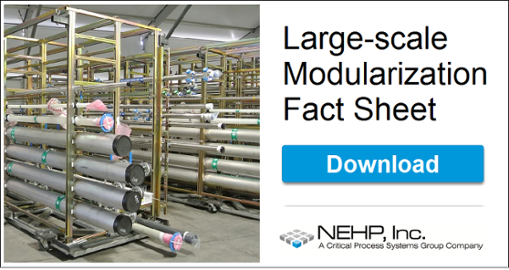Offsite Manufacturing and Job-Site Safety
Modular offsite construction, also known as prefabrication, offers several advantages for the construction of utility intensive high-tech facilities. By fabricating modular assemblies offsite and delivering them to the job-site complete, the time, cost, and safety liabilities associated with traditional stick-built construction are greatly reduced. Below, we will explore specifically how modular construction improves safety both on and off the job-site:
/LSM%20Video%20Snip%2005.png?width=1670&height=833&name=LSM%20Video%20Snip%2005.png)
-
Reduced On-Site Work: Modular construction involves fabricating building components off-site in a controlled factory environment. This reduces the amount of work that needs to be done on-site, minimizing exposure to hazardous conditions such as extreme weather, uneven terrain, or high-risk activities like working at heights. In 2016, according to OSHA’s statistics release on Construction's “Fatal Four”, the leading causes of fatal injuries were from falls and being struck or caught between objects, as well as electrocution. These causes made up 63.7% of fatal injuries. Moving production offsite reduces the amount of non-standard and/or hazardous working conditions on-site.
-
Controlled Environment: Factory settings provide a controlled environment with standardized processes and safety protocols. Workers are less exposed to unpredictable conditions, reducing the likelihood of accidents caused by weather-related hazards, debris, or unsafe working conditions. For example, the controlled climate of a factory setting does not expose workers to the risks of working in cold or wet conditions. Eliminating slippery surfaces, eliminating the potential for moisture around electrical activities and the general overall comfort level of the laborers all lead to increased project safety.
-
Decreased On-Site Traffic: With the majority of construction work completed off-site, there is a decrease in the number of vehicles and heavy equipment on the construction site. This reduces the risk of accidents related to vehicle movement, collisions, and pedestrian injuries. This also decreases on-site foot traffic, freeing up project space, which allows for greater control and monitoring of site hazards. With less labor activity on the job site, it becomes easier for management and EHS personnel to oversee and ensure other site hazards can be minimized.
-
Efficient Material Handling: Modular construction allows for better organization and management of materials in the factory setting. This reduces the need for on-site material storage and handling, minimizing the risk of accidents related to material handling, such as trips, falls, or injuries from lifting heavy objects.
-
Streamlined Processes: Prefabrication involves highly coordinated processes with detailed planning and scheduling. This minimizes the need for on-site adjustments, change orders, or improvisation, reducing the likelihood of errors, delays, and accidents caused by rushed or haphazard work.
-
Quality Control: In a factory environment, quality control measures are more easily implemented and monitored. Components are manufactured to precise specifications, reducing the risk of defects or structural failures that could compromise safety on-site.
-
Less On-Site Assembly Work: Modular construction involves assembling pre-fabricated components in a focused environment that is free of the distractions and potential hazards that can be introduced by other contractors or laborers activities. This reduces the time workers spend in potentially hazardous situations, such as working at heights or in confined spaces, as well as exposure to tasks involving cutting, welding, or other potentially dangerous activities.
-
Improved Training and Oversight: With a significant portion of construction work centralized in a factory, it becomes easier to provide comprehensive training and oversight to workers. This can include safety training, equipment operation, and adherence to safety protocols, leading to a more safety-conscious workforce.
Overall, modular offsite construction offers a controlled, efficient, and streamlined approach to facility construction, which inherently improves job-site safety by minimizing exposure to hazards and risks commonly associated with traditional on-site construction methods.
NEHP is fundamentally changing how owners construct utility-intensive high-tech manufacturing facilities. If you would like more information about how we can help you with construction productivity improvement, please feel free to access our large-scale modularization fact sheet below:
OR
Click here to visit our large-scale modularization page.
